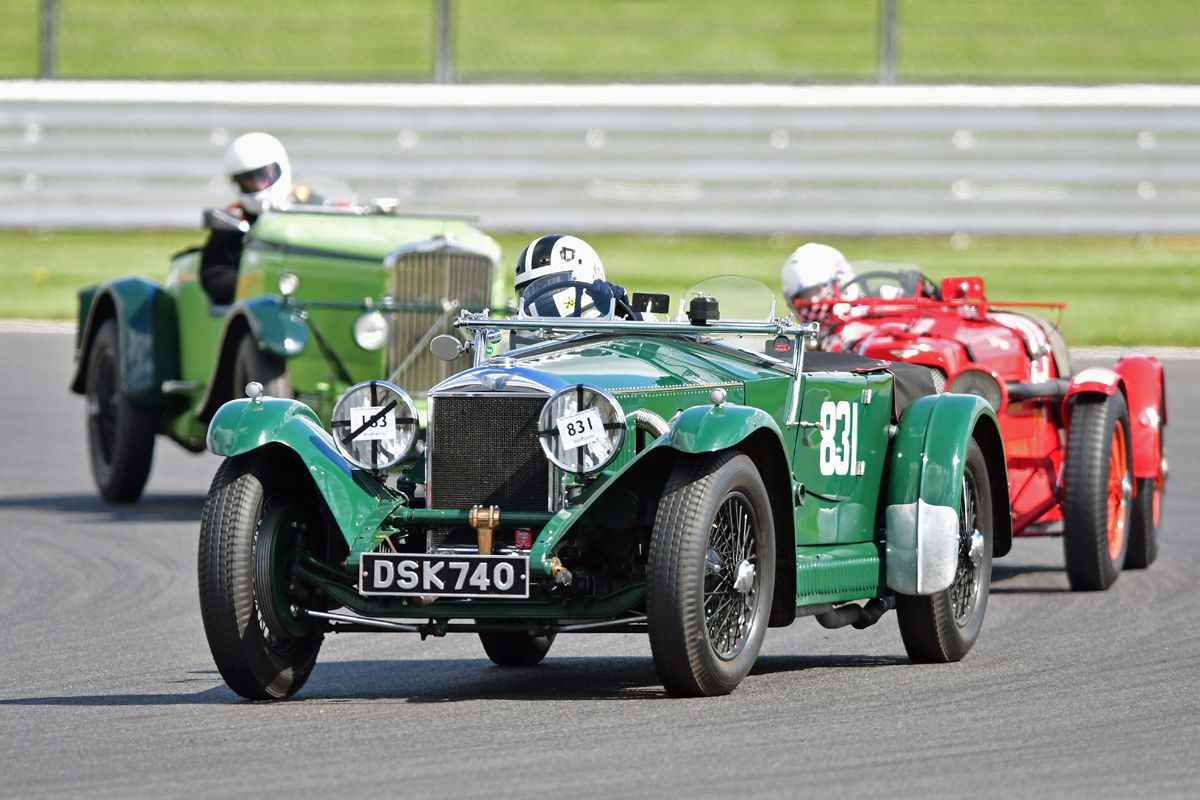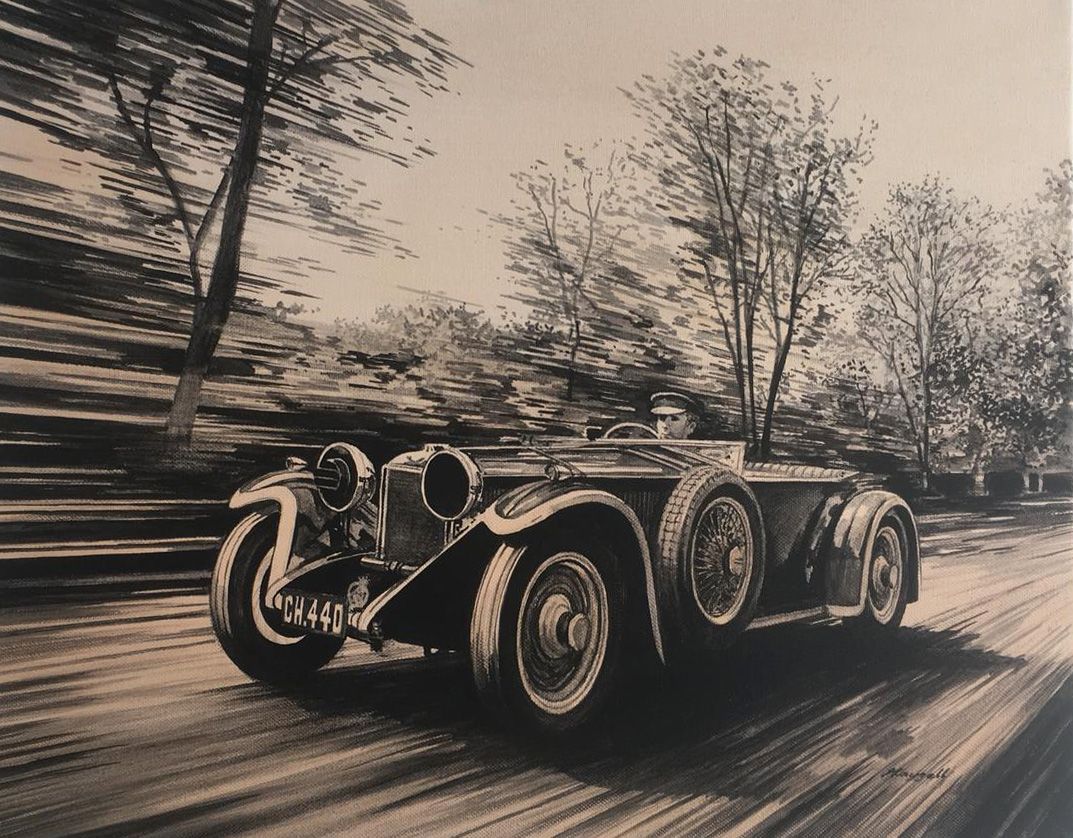The Victorious Invicta
Images: Courtesy Peter Bradfield
The Invicta Car Company was established in 1925 by Captain Albert Noel Campbell Macklin, a well-regarded English motoring enthusiast. Drawing on lessons from his earlier automotive ventures, Macklin aimed to create vehicles that offered "effortless performance"—a blend of immense pulling power and excellent handling.

Macklin initially developed a prototype powered by a 2.0-litre Coventry Climax before progressing to a 3-litre model and ultimately a car with a 4 ½-litre Meadows engine. The A Type Invicta came with options for either a short (3.0 metre) or long (3.2 metre) wheelbase. Then in 1930, a high-performance low chassis was unveiled with under-slung rear suspension.

The S-Type delivered such impressive torque that drivers could engage top gear (fourth) at just 10 kph and accelerate smoothly up to its top speed. The S-Type really gained fame as the first British car to reach 100mph (160 kph), earning it the nickname 'S100'.

Despite its engineering prowess and numerous racing successes—including victories by Violet Cordery, Macklin’s sister-in-law, and a class win by the renowned Donald Healey at the Monte Carlo Rally in 1930, followed by a first-place finish in 1931—Invicta faced declining fortunes. The economic downturn following the Great Depression led to diminished demand, and in 1935, following in the tyre tracks of Bentley and Lagonda, the company ceased trading.


Only 77 S-Type ‘Low Chassis’ models were built between 1931 and 1935, with an astonishing 68 examples still in existence today. Significantly, two of these were imported into India. The featured car, S 165, was the first to arrive, the only to be brought in new, and was delivered in 1934.

The celebrated second car which remains is part of the late Pranlal Bhogilal collection and was imported in the early 1960s. It has a documented history from 1966 when Roni Khan, a passionate collector, acquired the vehicle. Khan used the Invicta extensively as a daily driver until 1978, covering thousands of miles and participating in historic vehicle rallies. He often demonstrated the car's remarkable torque by ascending the steep slopes of Bombay’s Malabar Hill in fourth gear from a standstill. This Invicta held special significance for Khan, as he even proposed to his wife, Sherena, in the car while navigating a curve at speed. Since 1978, the vehicle has been preserved as part of the Pranlal Bhogilal collection.

The car we are featuring is the one that arrived in 1934, delivered new to an enigmatic and unresearched wealthy Indian. It later passed through the hands of a British Army Officer, was raced in Calcutta during the 1950s and was exported again in 1966. Although it has been said that the car was smuggled out, it shouldn’t have been as the ban on export of cars came through only in 1972.

This car is still alive and well, and was auctioned by Bonhams, in December 2015. Since then, it has been owned by Invicta enthusiast and expert, Peter Bradfield, who has meticulously traced the history of the car.
“Chassis S 165 was ordered by its first owner, Nizam Uddin Valuddin Jillani of Naunada on 6th March 1934,” explained Bradfield. “He has been described as a Maharaja although this has yet to be confirmed. He must have been wealthy and if not a maharaja, then one of the great zamindars, or millionaire merchants. We know he was impatient to get his new car from the account of Albert Deavin, one of the fitters from 1934 who built the car in the London works, and who was re-united with the car in 1992 and told how the new owner had telephoned the works to hear about the progress. Being told that the car was practically finished he demanded to hear the horns, so the car was pushed as near as possible to the open office window and Deavin sounded the horns while the new owner listened appreciatively. The car was shipped to India either later that year or early in 1935.”
The history file contains an original Registration Book from 1937 issued by the Calcutta Police to Nasir Kurishi Esq who may have been the car’s second owner. This wonderfully preserved historic document confirms its chassis and engine number along with its Calcutta registration number 49668 that appears in several period photographs.
The next owner in 1940 was Jimmy Braid, a Scot living and working in Calcutta. He in turn sold the car to a new owner, who seems to have raced the Invicta at the Alipore Mint racing circuit during the 1950s.

In May 1965 Swedish engineer and car enthusiast, Lars de Jounge discovered the car near Bombay with the help of his friend Roni Khan. When he returned to Europe soon after, he took his Indian Invicta with him. Bradfield resumed: “The car came back in poor condition, and he entrusted the engine rebuild to the esteemed mechanic Maurice Leo. Rather than restore the original unit, Leo provided De Jounge with an upgraded one – a W.O. Bentley-improved motor sourced from a Lagonda LG 45 that used the same 4½-litre Meadows powerplant. At that time, it was common practice to replace engines without concern for preserving original parts due to matching numbers. The original engine stayed with Leo in Beaconsfield while the car, in 1970, travelled to California, where De Jounge had relocated.”
The next custodian of the car was Don Williams, of Blackhawk Museum fame (The Legend of Don Williams). He acquired S 165 in 1972 and held onto it for 18 years. The car achieved significant recognition, placing third overall at the Pebble Beach Concours in 1975 and later being featured in the Automobile Quarterly, Vol. 15, No. 3, in 1977.
“S 165 remained in the United States until 1990, when Derek Green of Cedar Classic Cars Ltd. purchased it,” believes Bradfield. “It appeared at a Sotheby’s auction in London on March 16, 1991, where it was acquired by Nigel Dawes, a respected dealer. After undergoing some cosmetic enhancements, the car was auctioned again at a Brooks event in Olympia in October 1992. Here it found a proper new owner with Christopher Jacques, known for his world-famous croquet set company. Jacques recognised the increasing value of matching engine and chassis numbers and embarked on a search to recover the original. Remarkably, he traced the engine back to Maurice Leo and after parting with £5,000 was able to reunite it with the car following a 28-year separation!”




In 1995, Jacques sold S 165 through London dealer Gregor Fisken to Peter Livanos, in a transaction facilitated by Livanos' business associate and Aston Martin partner, Victor Gauntlet. Both Livanos and Gauntlet were avid participants in historic motorsport events, and S 165 was notably entered in the 1997 Mille Miglia. However, since Livanos already owned another S-Type, he put S 165 up for sale at a Brooks auction in Olympia on April 14, 1999.
The car was bought by Midlands-based collector Gordon Willey, who owned it for 16 years until 2015 when Peter Bradfield acquired it. Since then, S 165 has been maintained by marque expert Paul Kitcher and has competed in numerous prestigious events. These include the 2016 VSCC Pomeroy Trophy, the Prescott Hillclimb, the Mille Miglia, the Silverstone Classic in 2017 and 2019, the Goodwood Revival in 2017 and 2021, and the Flying Scotsman Rally in 2018. The car has also been showcased at numerous shows and concours events, winning the 'Spirit of Motoring' award at the 2016 Blenheim Concours and placing second at the 2022 Levitt Concours at Hampton Court.

One of only 77 Low Chassis Invictas ever built and among fewer than 30 featuring the coveted Carbodies Tourer coachwork, S 165 stands out as a highly original and historically significant vehicle with a captivating international history that traces back to India, particularly Calcutta.
In August 2025, Pebble Beach Concours d’Elegance will have a class dedicated to the Invicta S Type – this very special marque deserves the recognition it will get, especially as a brace of these cars have links with India. Can we expect to see both on the field next year?
Comments
Sign in or become a deRivaz & Ives member to join the conversation.
Just enter your email below to get a log in link.
